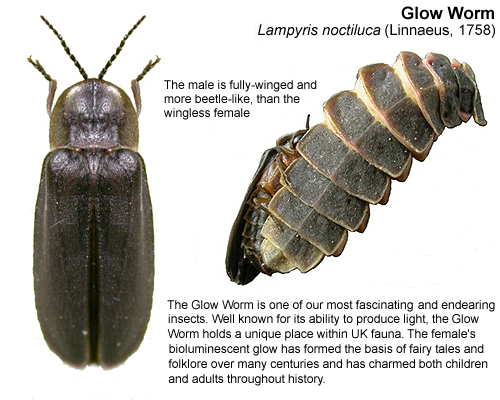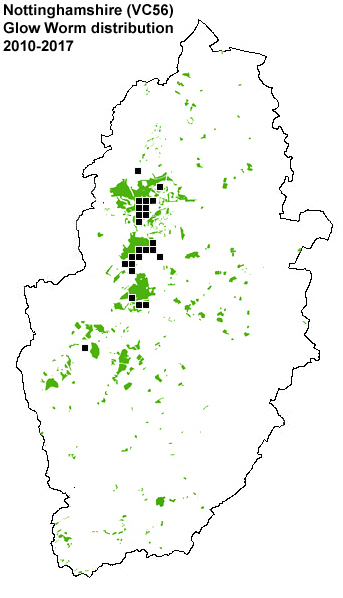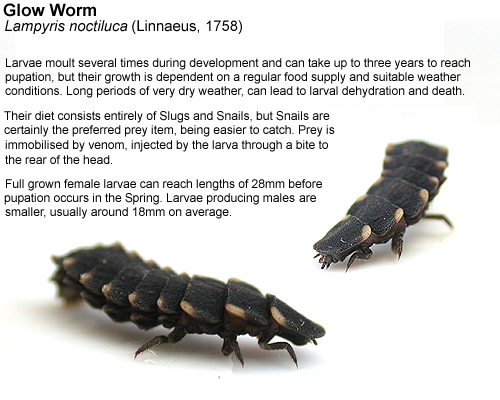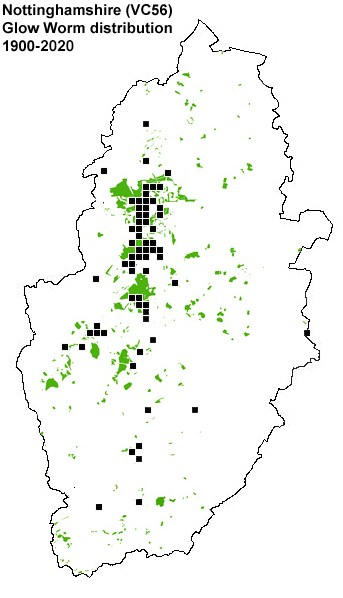

| The Glow Worm in Nottinghamshire |
| ... |
| The Glow Worm is
without doubt, one of our most fascinating insects. Most
famous for having the ability to produce its own light,
the green bioluminescence emitted by the female Glow
Worm, has formed the basis of countless fairy tales and
folklore over centuries. Still regarded by some authorities as being both nationally and locally common, this delightful beetle appears to be in a serious decline. Habitat loss through urbanisation and industrial development, the use of pesticides and herbicides in modern farming practices and the increase in light pollution, are believed to have contributed to the Glow Worm's decline. Nottinghamshire is fortunate in having one of the largest and most well known Glow Worm colonies in the UK. Found in the heart of Sherwood Forest, the former Pine plantation at Clipstone Old Quarter has almost become synonymous for producing the UK's earliest females during the Spring and Summer months. |
 |
|
| ... | ||
| We have studied Clipstone Old Quarter's Glow Worms since 2008 and spent hundreds of hours in the field and learned a great deal about them. But there is still much more to learn from a beetle which we originally thought had already offered its secrets to the world of science. |
| ...... | ||
 |
The Glow Worm's largely
nocturnal habits, means that it can be a difficult insect
to see and you do have to put in a degree or two of
effort. But its not just its nocturnal nature that makes
seeing them difficult. Survey work has provided evidence
that it is becoming increasingly difficult to see Glow
Worms in Nottinghamshire, as their numbers decline. Regular surveying from a small band of volunteer surveyors and Glow Worm enthusiasts taking part in the Nottinghamshire Glow Worm Survey, has showed that they have died out from many of their former sites. Glow Worms can only spread purposefully by how far the larvae can walk. As this is minimal and suitable habitat has become fragmented through development, changes in land use etc, it is generally impossible for existing populations to spread. So it is vitally important that we protect known Glow Worm sites now, to have any chance of future generations being able to see them. Part of the problem is that Glow Worms have no protection in law, as they are still widespread across the UK and not regarded as having need of protection. Glow Worms traditionally prefer grassy habitats. Disused railway lines, woodland rides and edges on well drained soils, are all ideal sites. Roadside verges were once regularly reported locations for Glow Worms, but with the increase in gritting during the Winter months, our roadside verges have probably become unsuitable for both prey items and Glow Worms. Female Glow Worms are unable to fly, but the fully-winged male is more typically beetle like. Both adults do not eat, but it has been found that they can take on water and males have been observed visibly drinking from water droplets (Dale, M.). Life-cycle The light produced by the female Glow Worm is known as bioluminescence. Quite common in a range of marine invertebrates, there are very few UK land-based invertebrates that have the ability to glow. Certainly some Geophilus Centipedes can and these are sometimes incorrectly reported by members of the public as Glow Worms. |
|
| ...... | ||
| Bioluminescence
is the produced reaction when Luciferin molecules are
oxydised to produce Oxyluciferin. The enzyme Luciferase
acting as the catalyst in the reaction. The light
produced by Glow Worms is extremely efficient and loses
just 2% in energy. Females glow for several hours each
night to attract a mate, but males can also glow to a
much lesser extent. Male Glow Worms produce extremely
short-lived, characteristic glows (flashes) in flight
over low vegetation, but larvae and pupae also have the
ability to glow, sometimes profusely. Both larval and pupal glows are easily seen after dark. The bioluminescence produced by pupae is especially interesting, as it is clearly triggered in response to vibration or touch. Pupae kept in captivity will regularly glow as soon as the room is entered. Larvae often glow regularly when hunting, typically producing short glows of around three to four seconds duration at a time. Larval bioluminescence has been found to be greatest during August and September, when it is often characterised by these regular short glows, but can be for considerably longer. |
| ...... | ||
| The tendancy for long
duration larval glows increases during September and
October, as larvae prepare for over-wintering. Long
duration larval bioluminescence is often produced by
larvae sat motionless on leaves and stems well off the
ground. The trigger point or date for the cessation of all larval bioluminescence in Autumn remains unknown, but in 2012 this was around the time of the Autumn Equinox, although we found no evidence of this during our research the following year and it is perhaps more likely to be temperature dependant. The majority of female Glow Worms manage to attract a mate within a few hours of glowing on their first night after emergence, but some females glow for anything up to three weeks before finally attracting a mate. In some years, there are increased numbers of males within a population and it is not unusual for a number of males to be found with a female. We also suspect (based on our own observations) that some female Glow Worms also rely on pheremones to attract a mate - effectively doubling their chances of successfully mating. |
 |
|
| ...... | ||
| Mating lasts for an hour or so and the process of egg laying begins almost directly after. The round yellow eggs are laid just into (or on) the soil substrate, usually in available cracks and crevices rather than directly in the open. Moss and leaf litter are also used for egg laying. Hatching takes place in about three weeks and both eggs and larvae are extremely prone to dessication in periods of hot, or very dry weather. Glow Worm larvae are carnivorous, feeding entirely on a diet of Slugs and Snails and the larval stage can last up to three years before pupation. In captivity, the larval stage can be completed within a year if conditions are warm and the food supply is good. | ||
| //// |
 |
In the
Spring, fully grown larvae wander in search of a suitable
pupation site. Pupation takes place with little attempt
at concealment, often on the ground under a leaf or other
vegetation. The pupation period varies between the sexes,
with males generally emerging around a week later than
females. Emergence occurs after about 14 days for females and 21 days
for males. A brief history of the Glow Worm in Nottinghamshire Thanks to the surveying work of a handful of volunteer surveyors over the last few years, we finally know more about the current status of the Glow Worm in Nottinghamshire than we did five years ago. We've written a great deal on the plight of Glow Worms in Nottinghamshire (VC56) and often opened with the comment that "we know liitle more about the status of the Glow Worm in Nottinghamshire now, than Victorian naturalists did over a century ago". That comment was certainly true a few years ago, but survey work means that we can categorically state that the Glow Worm has indeed declined in the county. Historically, the lack of published records would suggest that the Glow Worm has never been widespread in Nottinghamshire at all and has generally been confined to the wider Sherwood Forest area. In the south of the county, there are records from Lambley in 1944, Carlton in 1949 (now a housing estate), near Gotham in 1969, Keyworth in 1977 (now a housing estate), Colwick Woods until 1970 and from Holme Pierrepont in 1992. In north Nottinghamshire, the paucity of records continues. In 1992, Glow Worms were reported from Blyth, reportedly from a garden and possibly from woodland just east of Hodsock Priory. There are no other confirmed records from areas north of Worksop, east of Ollerton and Nottingham, around Southwell, Retford and Newark, although J.W. Carr writing in 1916, does mention that Glow Worms were reported from the Retford district. Mercia Mudstones comprise much of the Trent Valley flood plain and is the lowest part of Nottinghamshire. This whole area is depleted of Glow Worm records but for the mentioned Carlton, Colwick and Holme Pierrepont areas of Nottingham and Gotham and Keyworth in the far south of the county. The dot in the very east of the county map is from Stapleford Moor in 1990, but by this point, Mercia Mudstone has given way to Lias Limestones. |
| //// |
| It seems clear then, that the Glow Worm's Nottinghamshire distribution, is as much governed by geology as anything else, preferring soils other than that found in the Trent Valley, with most known sites being located on Sherwood Sandstones in west Nottinghamshire. Accordingly, the majority of sites would also have once been within the most wooded parts of Nottinghamshire. Visits to Sherwood Forest or Clumber Park, offer the best chance of seeing Glow Worms in Nottinghamshire now. |